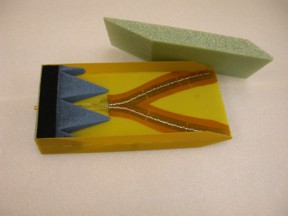Research Areas
The research interests of the Microwave Sensing & Imaging Lab include the following areas:
-
■ Antennas: electrically small antennas, ultra-wideband antennas, antenna arrays, antenna packaging, MIMO antennas
■ Microwave sensing: ultra-wideband radar systems, ground-penetrating radar systems, foliage-penetration radar systems
■ Signal processing: physics-based signal processing, radar image processing
Application of electromagnetic wave is indispensable to modern life. The applications include communications, radar, sensing, power transfer, medical treatment, etc. These applications require some forms ofantennas to be able to send and receive electromagnetic energy. The antenna is the interface between the circuit and the air and takes a large part of the physical volume in most systems. Since the antenna is the first stage of a system, the appropriate design, manufacturing, and/or use of the antennas determine the significant portion of the system performance. Currently and in the future, the electromagnetic applications demand the antennas to be invisible or very small while functioning properly. Thus, it is one of interests that we would develop new types of antennas that are electrically small and/or that operate over an ultra-wideband.
We are also interested in microwave sensing systems as well as communications systems. The microwave sensing is considered to be the most advanced topic among numerous electromagnetics application areas. It requires a fair knowledge of target being sensed and the surrounding media, the understanding of RF systems, the use of ultra-wideband antennas, the engineering solutions to minimize the self-interaction between the antenna and the system, and the signal processing techniques. We are particularly interested in imaging and detection/identification of concealed objects using ultra-wideband radar technologies.

Photograph of the resistive vee antenna. The antenna is loaded with 28 chip resistors and encased in a low radar cross section package. This antenna package is suitable for ultra-wideband, short-pulse radar applications (500 MHz — 8 GHz).